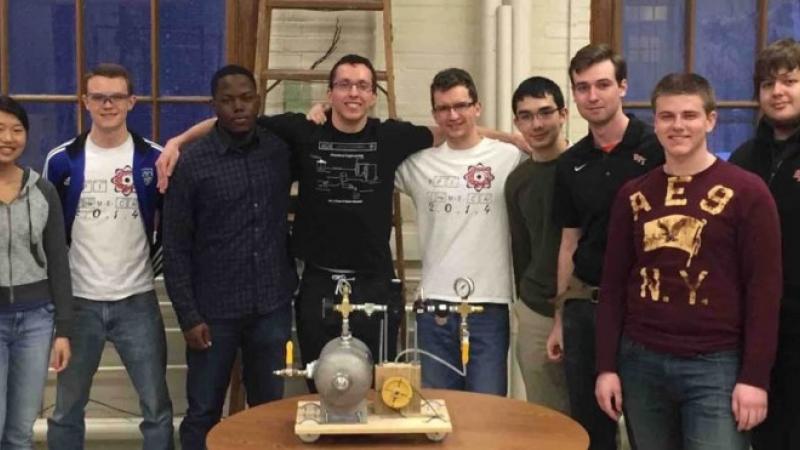June 3, 2016

(The RPI ChemE Car team (pictured above) and Ian Gaudette, a Chemical Engineering student and the interim president of the team, wrote this post about a challenge (and their on-the-fly solution) they ran into at their first showing in the American Institute of Chemical Engineers (AIChE) Northeast Regional Conference competition. The competition "engages college students in designing and constructing a car powered by a chemical energy source, that will safely carry a specified load over a given distance and stop," according to AIChE. The post originally appeared in the RPI ChemE Car team newsletter and has been slightly adapted for the Approach.)
 The RPI ChemE Car team designs, tests, and optimizes a small-scale car powered and controlled by a chemical reaction. We compete with other schools through the American Institute of Chemical Engineers (AIChE), and our club offers the design/build competition specifically relevant to Chemical Engineers. We offer plenty of opportunities to gain real engineering experience and open-world hands-on design, both of which we consider to be vital aspects of an engineering education, and other majors are welcome to join if interested. The Rensselaer team is relatively new — this year we competed for the first time in the AIChE Northeast Regional Conference, and next year we're setting our sights on the national competition.
The RPI ChemE Car team designs, tests, and optimizes a small-scale car powered and controlled by a chemical reaction. We compete with other schools through the American Institute of Chemical Engineers (AIChE), and our club offers the design/build competition specifically relevant to Chemical Engineers. We offer plenty of opportunities to gain real engineering experience and open-world hands-on design, both of which we consider to be vital aspects of an engineering education, and other majors are welcome to join if interested. The Rensselaer team is relatively new — this year we competed for the first time in the AIChE Northeast Regional Conference, and next year we're setting our sights on the national competition.
The Northeast conference, held April 23 at the UMassAmherst, was a major milestone for us, as it was the first time any of the current club members have been in the competition, and it was the competitive debut for our pressure based car (which you can see in the image on the right).
We placed sixth out of a total of 13 competing teams, traversing 12.6 meters with a goal of 17.4 meters. We completed both of our runs without any incidents, making our car one of the most reliable at the competition. We received multiple compliments on how exciting our car was; it finished its run in under 10 seconds while most other cars took just under 2 minutes to traverse the same distance. One observer even commented that our car "scared the *$&@ out of them" when it started, which we took as a compliment to its power. We were also the only team to successfully run a pressure car—all other successful teams where either hydrogen fuel cell or battery based—which we were very proud of.
It wasn't all smooth sailing though. In fact, we almost didn't compete at all. At the safety inspection which took place only a couple hours before the competition started, we were told that we would be disqualified for not having any sort of secondary containment to catch leaks from our vessel in the event that a leak occurred. We were also told we had a snowflake's chance in July of being able to fix the issue in time to compete; we didn't let this get us down though, and we immediately started planning our next move.
In a fit of crisis engineering, we drove to the nearest store to get the most readily available thing we could think of to meet our needs: plastic storage containers. After making a patchwork of plastic containers that would catch leaks out of any of the connections to our vessel, we were cleared by the safety coordinator and were back in the game (below is a picture of our plastic container strategy in action).
This was a great experience for all of us where we got to learn plenty of lessons and have fun doing so. We still have a young, growing team and we look forward to improving our car and making an even stronger showing at next year's competition.
Of course none of this would have been possible had it not been for the generosity of everyone who provided support to the team either through sponsorship, part donations, advisory positions, or emotional support. While we're on the subject, we would like to thank SI Group, Cambridge Security Seals, the Rensselaer School of Engineering, and David Eckhardt for their financial support; Kinequip and Swagelok Albany Valve & Fitting for their donation of parts; our new adviser Pankaj Karande who has experienced our team's growing pains with us; and Joel Plawsky and the Department of Chemical and Biological Engineering at Rensselaer who provided the last-minute chunk of funding we needed in order to complete our tests and then compete. We are extremely grateful for everything you have all done for us, and we hope that you will continue to support our efforts in the upcoming years.

